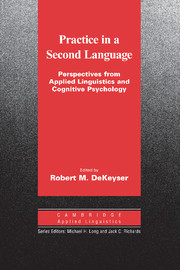II: INSTITUTIONAL CONTEXTS
Published online by Cambridge University Press: 27 January 2010
Summary
The chapters in this section illustrate the variety of specific concerns about the nature of practice that follow from different contexts for teaching a second/foreign language. In the foreign language context, Lourdes Ortega argues, one has to make an effort to make sure that practice is meaningful. She explains how pair or group work and electronic communication can help realize this goal and presents evidence that such activities do not necessarily jeopardize all concern for accuracy, evidence that interaction with other speakers of the same L1 presents advantages when it comes to negotiation of meaning or pushed output for grammar. The different native languages involved in a second language context make this negotiation of grammatical form harder, which helps to explain why students focus so much on lexis and pronunciation in that context. In the second language classroom, as Kris Van den Branden argues, drawing on his experience with child L2 learners in Dutch-speaking Belgium, communicating in the L2 may be more natural, but students do not get sufficient practice if no effort is made to bridge the gap between focused practice of the L2 and use of what was practiced in the “real” second language context, be it in other classes or in the world outside of school. Leila Ranta and Roy Lyster discuss a problem that is typical of immersion contexts: repeated L2 practice in the classroom with native speakers of the same L1 leads to students not realizing how far removed their classroom norms are from those of real native speakers.
- Type
- Chapter
- Information
- Practice in a Second LanguagePerspectives from Applied Linguistics and Cognitive Psychology, pp. 139 - 140Publisher: Cambridge University PressPrint publication year: 2007



